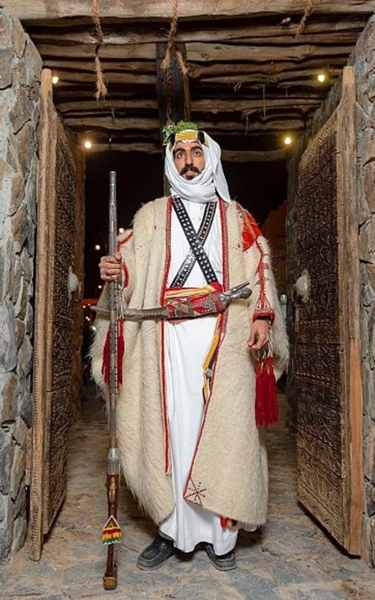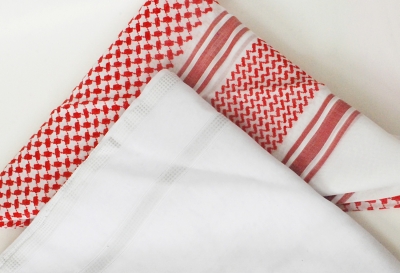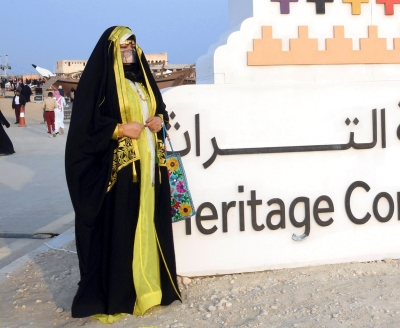

Personal Ornamental Plants are plants and herbs that certain communities in specific regions of the Kingdom of Saudi Arabia have adopted as embellishments and accessories for their traditional attire. These accessories are linked to a traditional heritage costume.
Applications of ornamental plants
Personal ornamental plants come in a wide variety and are used for various occasions. Adornment with such plants, including flowers and aromatic plants, is not limited to women, men have a share in their use as well. In the southern region of the Kingdom, men use aromatic plants either with their turbans or while bareheaded, wrapping their heads with various types of fragrant flowers available in the mountains.
In the southern regions of the Kingdom, women adorn themselves with fragrant blossoms and aromatic herbs, crafting intricate headpieces reminiscent of crowns. These adornments, known as 'muk'as' or 'gharaz', are placed elegantly on their foreheads or beneath their cheeks and secured with ornate bead or leather chokers beneath their veils.
A mixture of these plants may be used, similar to how women in Jazan prepare 'al-teeb', an aromatic blend of mountain plants traditionally applied to the hair. This is often accompanied by 'al-husn', a red powder applied to the hair parting, henna, al-shadher, and intricately arranged screwpine and al-khutor plants, known as 'al-shalfa' in Tihamah and 'al-ukra' in Farsan, commonly used for special occasions.
Aromatic plants used in decoration
The screwpine tree, or pandanus, is a highly branched tree that can grow up to six m tall. Women use its fragrant flowers as adornments, while the leaves are used to create handicrafts such as mats. Its leaves are thick and sharp and can grow up to seventy cm. They have a pleasant fragrance called spathe. The tree produces numerous small flowers surrounded by white bracts and contains many white stamens with an aromatic scent. It is commonly found in Wadi Dhi Ain, al-Baha Province.
The wild jasmine tree (al-Qan) is classified as a climber, a type of tree that climbs walls, trees, or rocks. Jasmine is one of the most beautiful flowering vines in the mountains of as-Sarah and al-Hejaz. It is characterized by white, fragrant flowers used to make flower wreaths or what is known as 'al-Ful' in Jazan.
Some of these plants are key components of the traditional attire for brides in Jazan Province, south of the Kingdom. The bride's head is adorned with Arabian jasmine, locally known as 'al-Ful al-Rassas' or 'Eqd al-Rassas'. Jasmine necklaces and garlands come in various types in Jazan, including 'al-Rassas', 'al-Kibsh', al-Mowarrad', and 'al-Mabrum', due to their pleasant aroma.
Basil, a member of the Lamiaceae family, is an annual herbaceous plant. Originating from the Middle East, Southeast Europe, and Southwest Asia, basil thrives in regions with mild winters. It can grow to a height of thirty to sixty cm and a width of about forty cm. Its leaves are round and aromatic, characterized by a strong, leafy, and slightly spicy scent, and are usually bright green.
Wormwood, the cottony green lavender, is a member of the Asteraceae family. It is a slow-growing perennial herb native to the Mediterranean region, Northwest Africa, Portugal, and central Spain. Its leaves are lanceolate, whole-edged, and opposite, and its small, light yellow flowers are about one cm in size and bloom in summer. Wormwood is often used in urban areas, parks, open public spaces, and gardens for its attractive appearance and pleasant aroma.
Headband/al-lawiyyah
In informal events, aromatic plants can be added to the top part of Saudi attire. All personal ornamental plants in the Kingdom are aromatic plants and fragrant flowers, such as screwpine, bulrush, basil, roses, yarrows, marjoram, and sanicle. Contrary to the typical custom of women wearing flower crowns,
men in the southern region of the Kingdom wear floral crowns known as fragrant headbands or locally as 'al-Asabah al-Aseeriyyah', due to their association with most southern provinces, especially Aseer Province. The name varies depending on the nature of the southern provinces. In Harrat as-Sarah Mountains, they are referred to as 'al-gharas' or 'al-lawiyyah', while in Tihamah, they are known as 'al-mikhdhara' or 'al-khodhour'.
Aromatic plants headbands
Headbands are also among the traditional attire accessories in the southern region as well. Men would let their hair grow long and wear headbands made of aromatic plants and flowers found in the mountains, such as yarrows, wormwood, basil, and Lavender. They would place these flowers on both sides of their heads, known as 'al-ghara'ez', and the center front, known as 'al-mankousa'. The plants were sewn onto the main round frame of the headbands to secure them, and one of its names is 'Asabah Mdalla'ah'.
There are eight types of al-Asabah al-Aseeriyyah (Aseerian headbands) in yellow and orange colors: bulrush, wormwood, screwpine, rue, basil, yarrows, marjoram, and sanicle. This diversity can be seen as a literal reflection of the rich natural environment found in most southern regions.
Ornamental plants in national festivals
In the national context, national festivals have been organized with visions and names associated with aromatic plants. For example, in 2019, the Ministry of Culture organized the 'Flowerman Festival' in Rijal Alma Governorate, Aseer Province. This festival is celebrated as part of the cultural heritage of Aseer Province, honoring floral wreaths that represent an iconic symbol. The festival focused on the beauty and diversity of these wreaths and showcased traditional crafts related to their making and gifting them to visitors.
Among these festivals is the 'Jasmine and Aromatic Plants Festival' held in Jazan Province by the Ministry of Environment, Water, and Agriculture. The festival aims to introduce jasmine and aromatic plants, for which Jazan Province is renowned, develop farmers' products, and provide seeds and seedlings.
Related quizzes

